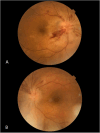The Review of Ophthalmic Symptoms in COVID-19
- PMID: 38803556
- PMCID: PMC11129748
- DOI: 10.2147/OPTH.S460224
The Review of Ophthalmic Symptoms in COVID-19
Abstract
The COVID-19 pandemic caused by SARS-CoV-2 had a significant impact on the health of the global human population, affecting almost every human organ, including the organ of vision. Research focus on understanding the pathophysiology, identifying symptoms and complications of the disease. Eye-related pathologies are important foci of research due to the potential for direct impact of the virus. Ophthalmologists around the world are reporting various symptoms of eye infections and ocular pathologies associated with SARS-CoV-2. The review of ophthalmic symptoms was conducted to help physicians of various specialties recognize possible ophthalmic manifestations of this viral disease. A literature review was conducted from January 2020 to July 2023 in the PubMed, MEDLINE, Science Direct, Scopus, Scielo and Google Scholar databases. The review of the literature showed that conjunctivitis is the most common ophthalmic symptom observed during the course of COVID-19 and can occur at any stage of the disease. Changes in the eye may result from the direct effect of the virus, immune response, prothrombotic states, comorbidities, and medications used. Symptoms related to the organ of vision can be divided into: changes affecting the protective apparatus of the eye, the anterior eye segment, the posterior eye segment, neuro-ophthalmic, and orbital changes. Ocular symptoms may suggest COVID-19 infection or appear several weeks after recovery. Following COVID-19 vaccinations, a diverse range of ophthalmic symptoms was observed in various locations and at different times, mirroring the ocular symptoms experienced throughout the course of the COVID-19 illness. It is important for physicians of all specialties to be aware of possible potential connections between eye diseases and SARS-CoV-2, in order to effectively diagnose and treat patients.
Keywords: COVID-19; SARS-CoV-2; ocular symptoms.
© 2024 Stawowski et al.
Conflict of interest statement
The authors report no conflicts of interest in this work.
Figures






Similar articles
-
COVID-19 and Eye: A Review of Ophthalmic Manifestations of COVID-19.Indian J Ophthalmol. 2021 Mar;69(3):488-509. doi: 10.4103/ijo.IJO_297_21. Indian J Ophthalmol. 2021. PMID: 33595463 Free PMC article. Review.
-
[Ocular symptoms in SARS-CoV-2 infection].Pol Merkur Lekarski. 2022 Apr 19;50(296):86-93. Pol Merkur Lekarski. 2022. PMID: 35436269 Review. Polish.
-
Ophthalmic Presentations and Manifestations of COVID-19: A Systematic Review of Global Observations.Cureus. 2023 Jun 20;15(6):e40695. doi: 10.7759/cureus.40695. eCollection 2023 Jun. Cureus. 2023. PMID: 37485114 Free PMC article. Review.
-
[Ophthalmic manifestations of COVID-19].Vestn Oftalmol. 2023;139(5):81-88. doi: 10.17116/oftalma202313905181. Vestn Oftalmol. 2023. PMID: 37942601 Review. Russian.
-
Ocular tropism of coronavirus (CoVs): a comparison of the interaction between the animal-to-human transmitted coronaviruses (SARS-CoV-1, SARS-CoV-2, MERS-CoV, CoV-229E, NL63, OC43, HKU1) and the eye.Int Ophthalmol. 2021 Jan;41(1):349-362. doi: 10.1007/s10792-020-01575-2. Epub 2020 Sep 3. Int Ophthalmol. 2021. PMID: 32880786 Free PMC article. Review.
References
-
- Mathieu E, Ritchie H, Rodés-Guirao L, et al. Coronavirus Pandemic (COVID-19). Our World in Data; 2020. Available from: https://ourworldindata.org/covid-vaccinations. Accessed June 9, 2023.
Publication types
LinkOut - more resources
Full Text Sources
Miscellaneous

